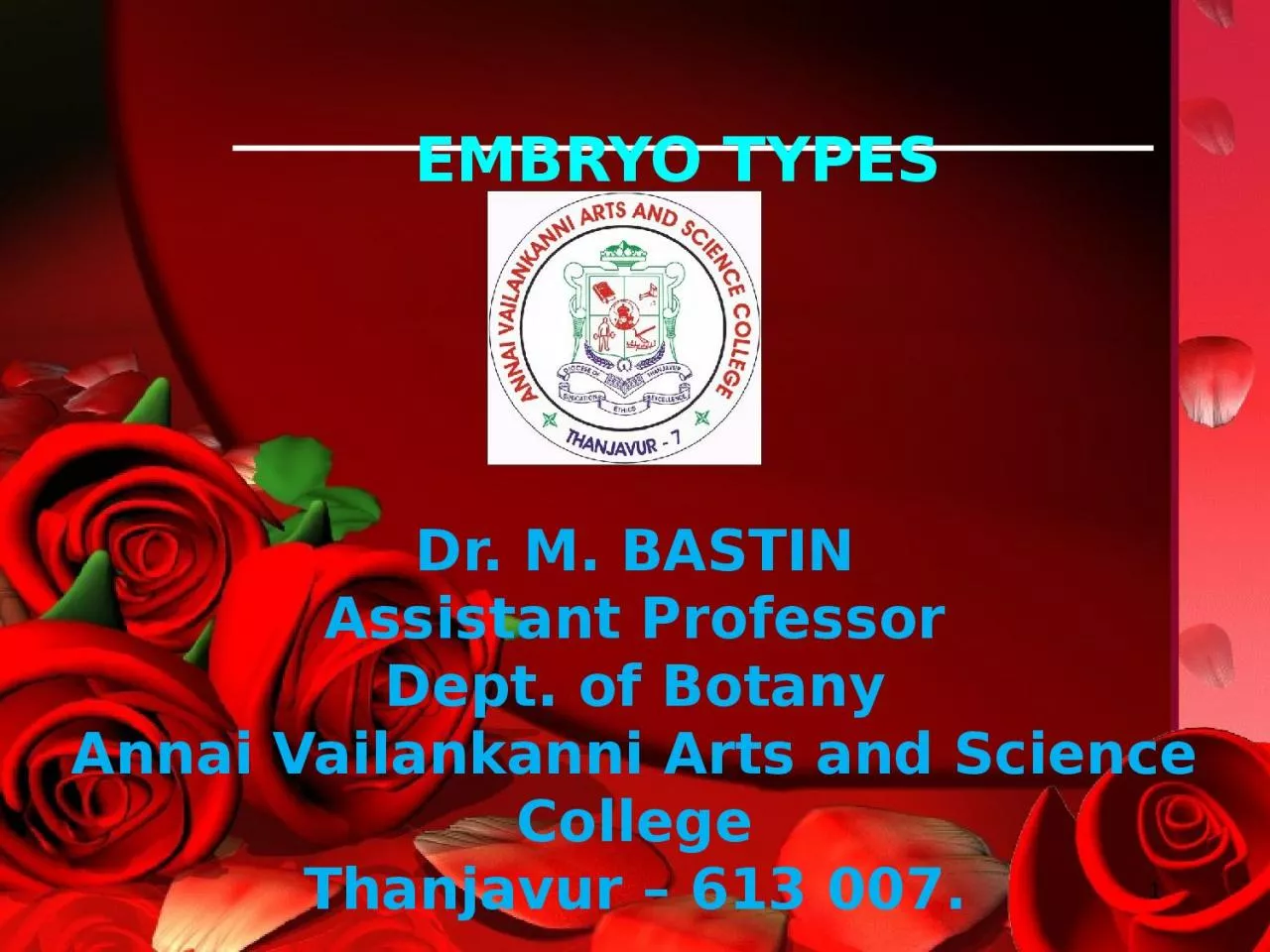

Assistant Professor Dept of Botany Annai Vailankanni Arts and Science College Thanjavur 613 007 Introduction Endosperm is the tissue produced inside the seeds of most flowering plants around the time of fertilization It surrounds the embryo and provides nutrition in the form ID: 932523
Download Presentation The PPT/PDF document "EMBRYO TYPES 1 Dr. M. BASTIN" is the property of its rightful owner. Permission is granted to download and print the materials on this web site for personal, non-commercial use only, and to display it on your personal computer provided you do not modify the materials and that you retain all copyright notices contained in the materials. By downloading content from our website, you accept the terms of this agreement.
Slide1
EMBRYO TYPES
1
Dr. M. BASTINAssistant ProfessorDept. of BotanyAnnai Vailankanni Arts and Science CollegeThanjavur – 613 007.
Slide2Introduction
Endosperm is the tissue produced inside the seeds of most flowering plants around the time of fertilization. It surrounds the embryo and provides nutrition in the form of starch, though it can also contain oils and protein.
This can make endosperm a source of nutrition in human diet. For example, wheat endosperm is ground into flour for bread (the rest of the grain is included as well in whole wheat flour), while barley endosperm is the main source for beer production.
Slide3Endosperm formation
There are three types of Endosperm development:
Nuclear endosperm formation - where repeated free-nuclear divisions take place; if a cell wall is formed it will form after free-nuclear divisions. Commonly referred to as liquid endosperm. Coconut juice is an example of this.Cellular endosperm formation - where a cell-wall formation is coincident with nuclear divisions. Coconut meat is cellular endosperm. Acoraceae has cellular endosperm development while other monocots are helobial.perm types
Slide4Helobial
endosperm formation - Where a cell wall is laid down between the first two nuclei, after which one half develops endosperm along the cellular pattern and the other half along the nuclear pattern.
Slide5Evolutionary origins
The evolutionary origins of double fertilization and endosperm are unclear, attracting researcher attention for over a century of research. There are the two major hypothesis:
The double fertilization initially used to produce two identical, independent embryos ("twins"). Later these embryos acquired different roles, one growing into mature organism and another merely supporting it. Hence the early endosperm was probably diploid, same as another embryo.
Slide6Endosperm is the evolutionary remnant of the actual gametophyte, similar to the complex
multicelular gametophytes found in gymnosperms. In such case acquiring the additional nucleus from sperm cell is the later evolutionary step.
Some gymnosperms, such as Ephedra(genus), do may produce twin embryos by double fertilization. Any of these two embryos are capable of filling in the seed but normally only one develops further (another eventually aborts). Also, the most basal angiosperms still contain the four cell embryo sac and produce diploid endosperms.
Slide7This nucleus may provide the parental (not only maternal) organism with some control over endosperm development. Then becoming triploid or polyploid are later evolutionary steps of this "primary gametophyte". Non-flowering seed plants (conifers, cycads, Ginkgo,
Ephedra
) form a large homozygous female gametophyte to nourish the embryo within a seed.
Slide8Role of endosperm in seed development
In some groups (e.g. grains of the family
Poaceae) the endosperm persists to the mature seed stage as a storage tissue, in which case the seeds are called "albuminous" or "endospermous", and in others it is absorbed during embryo development (e.g., most members of the family Fabaceae, including the common bean, Phaseolus vulgaris), in which case the seeds are called "exalbuminous" or "cotyledonous" and the function of storage tissue is performed by enlarged cotyledons ("seed leaves").
Slide9In certain species (e.g. corn, Zea
mays); the storage function is distributed between both endosperm and the embryo. Some mature endosperm tissues store fats (e.g. castor bean, Ricinis
communis) and others (including grains, such as wheat and corn) store mainly starches.
Slide10Anther Type
Bithecal
Monothecal
Slide11Monothecal
Canna
Hibiscus
Slide12Anther Wall Development
Slide13Tapetum type
Slide14Endothecium
type
Slide15Microsporogenesis
Slide16Pollen Nucleus Number
Slide17Ovule Nucellus (Megasporangium) Type
Slide18Angiosperm Reproduction – Embryogenesis and fruit formation
Slide19Megasporogenesis & Megagametogenesis
Slide20Megasporogenesis & Megagametogenesis
Slide21Megasporogenesis & Megagametogenesis
Slide22Megasporogenesis & Megagametogenesis
Slide23Ovule Integument Types
Slide24Ovule
Micropyle Types
Slide25Ovule Types
Slide26Ovule Position
Slide27THANK YOU